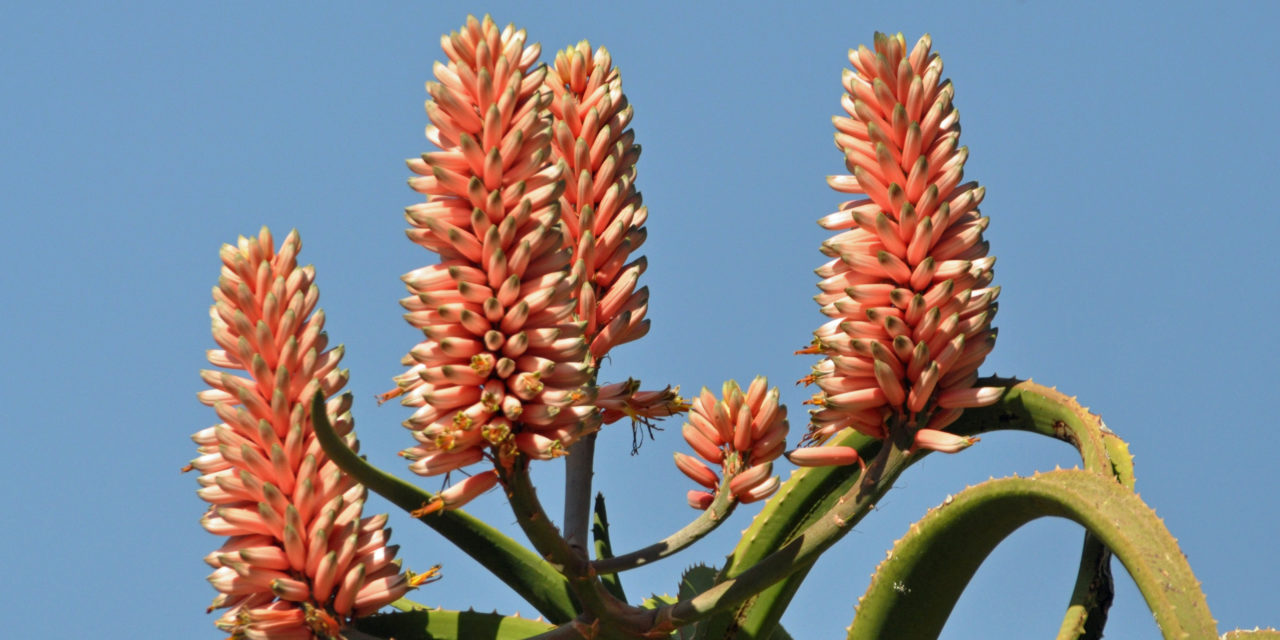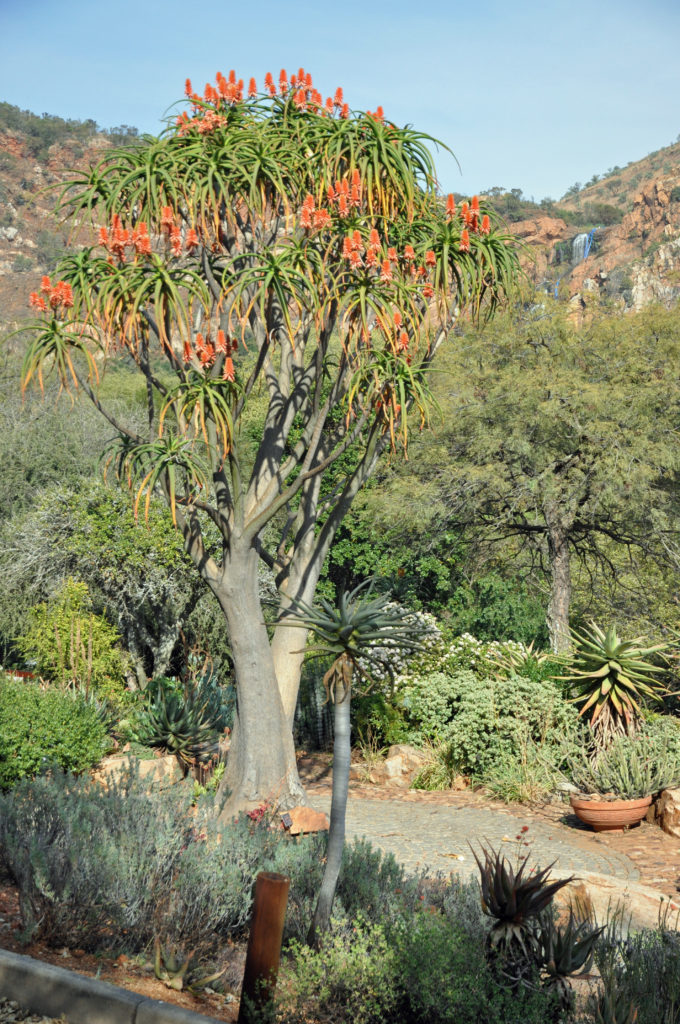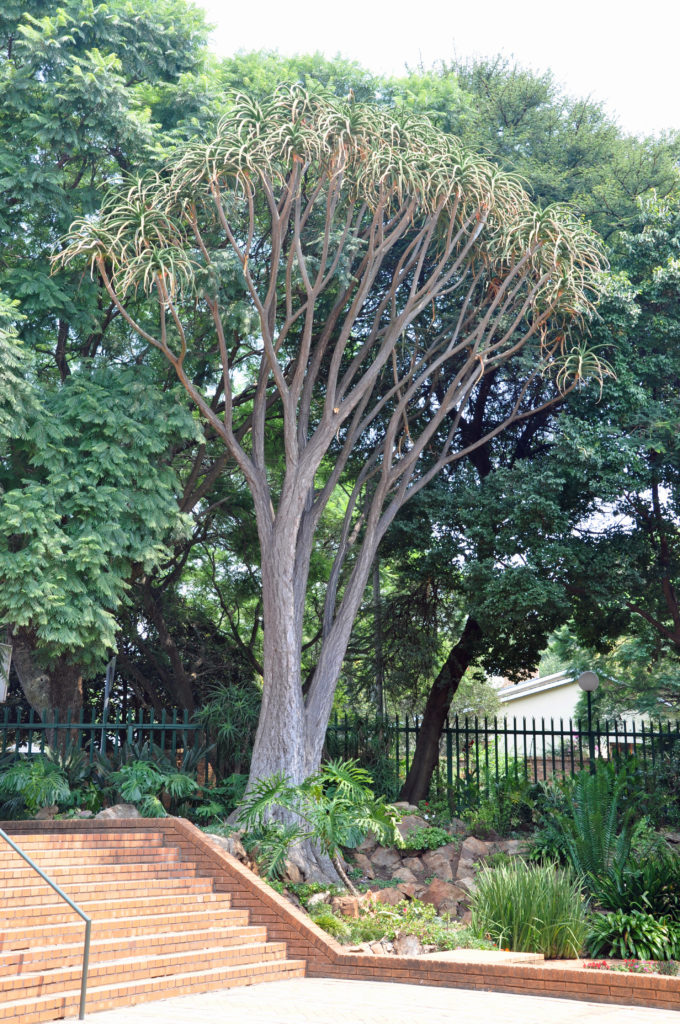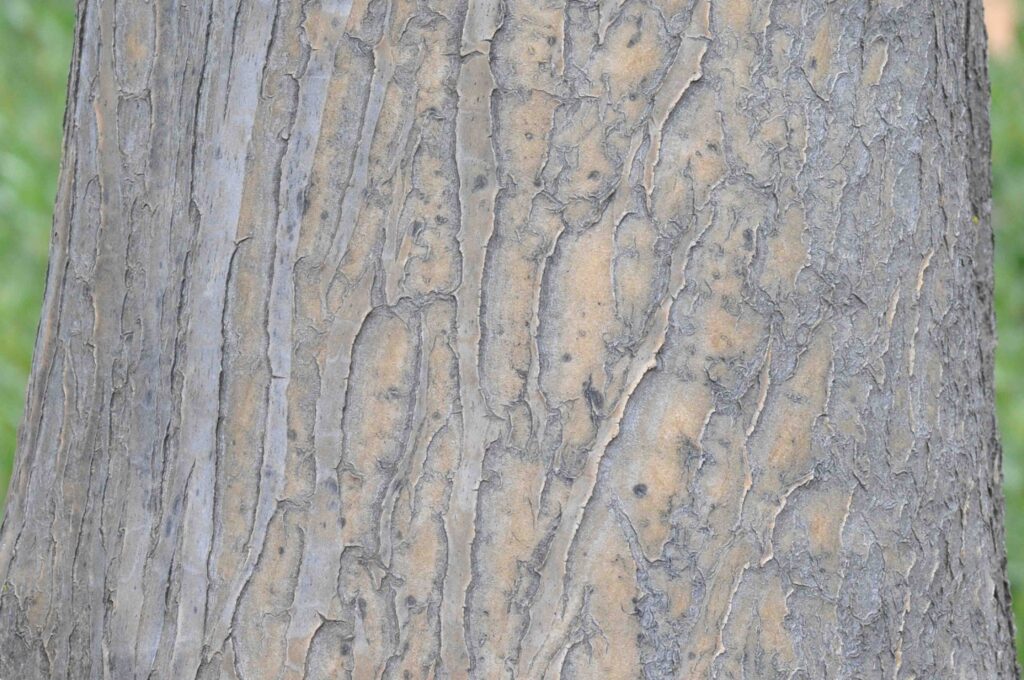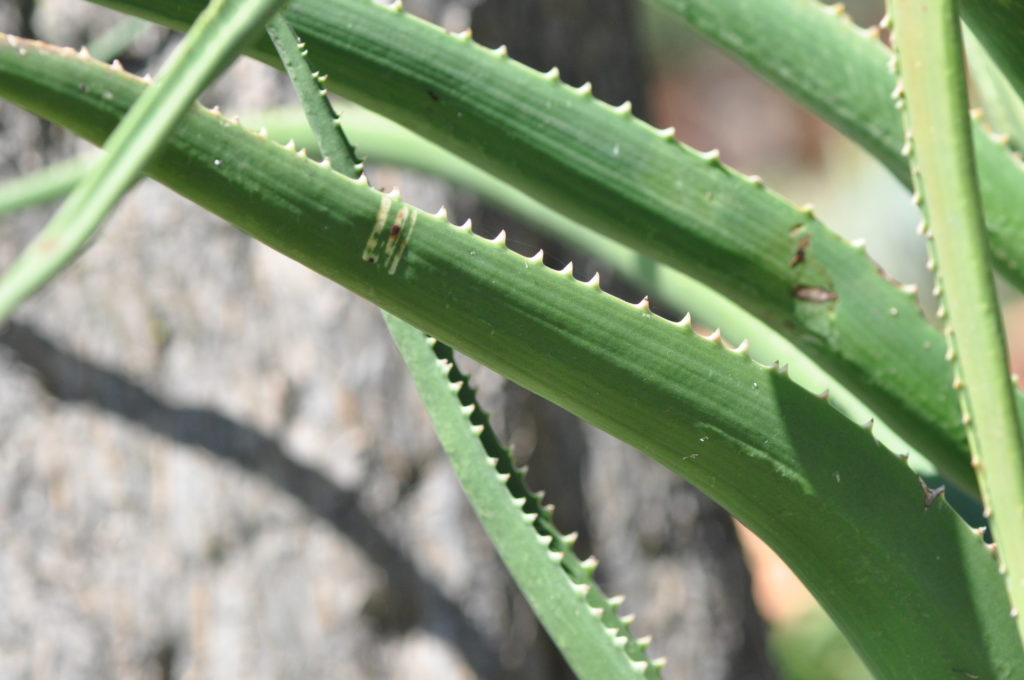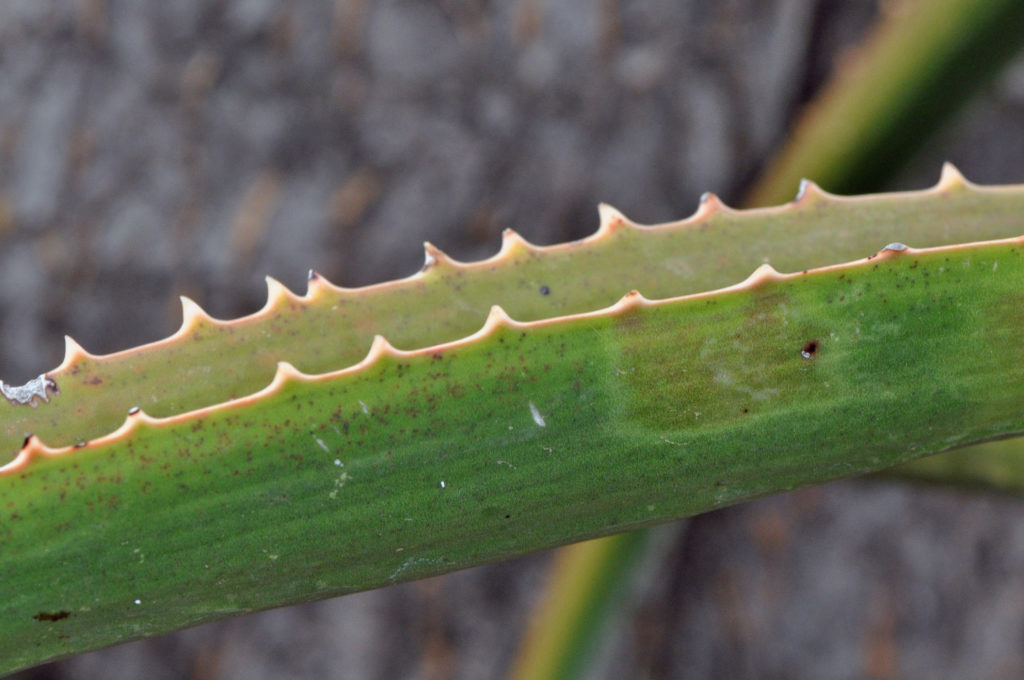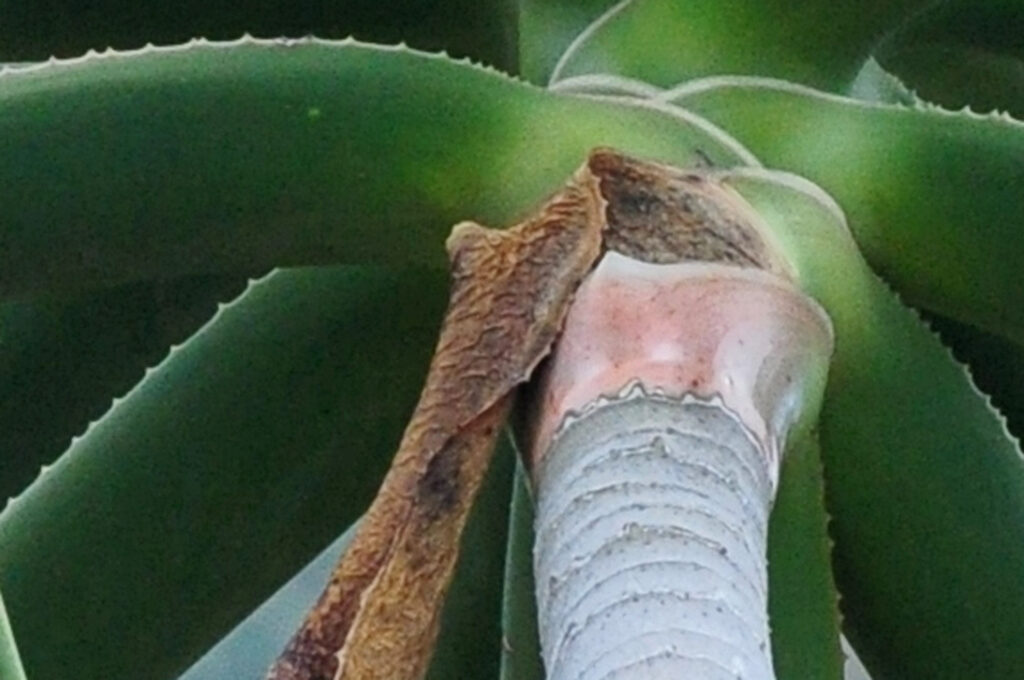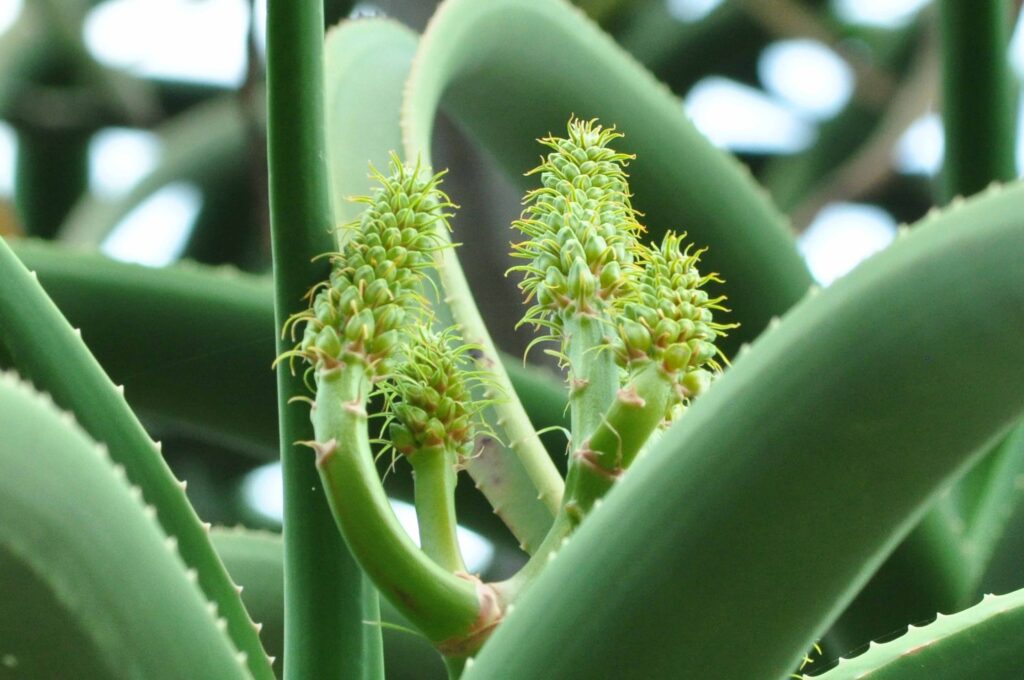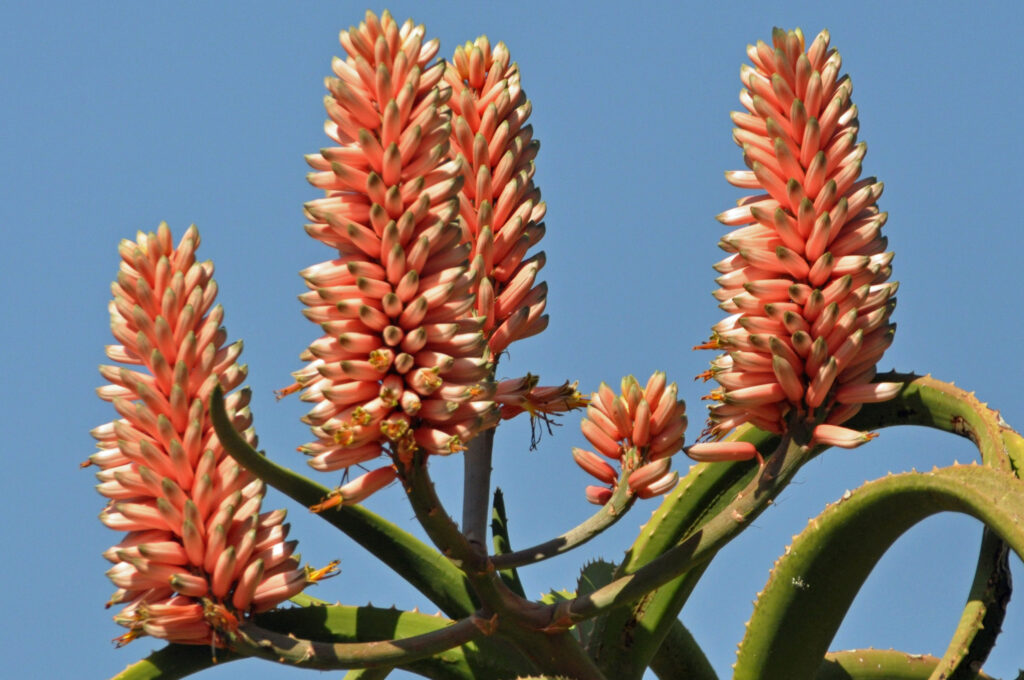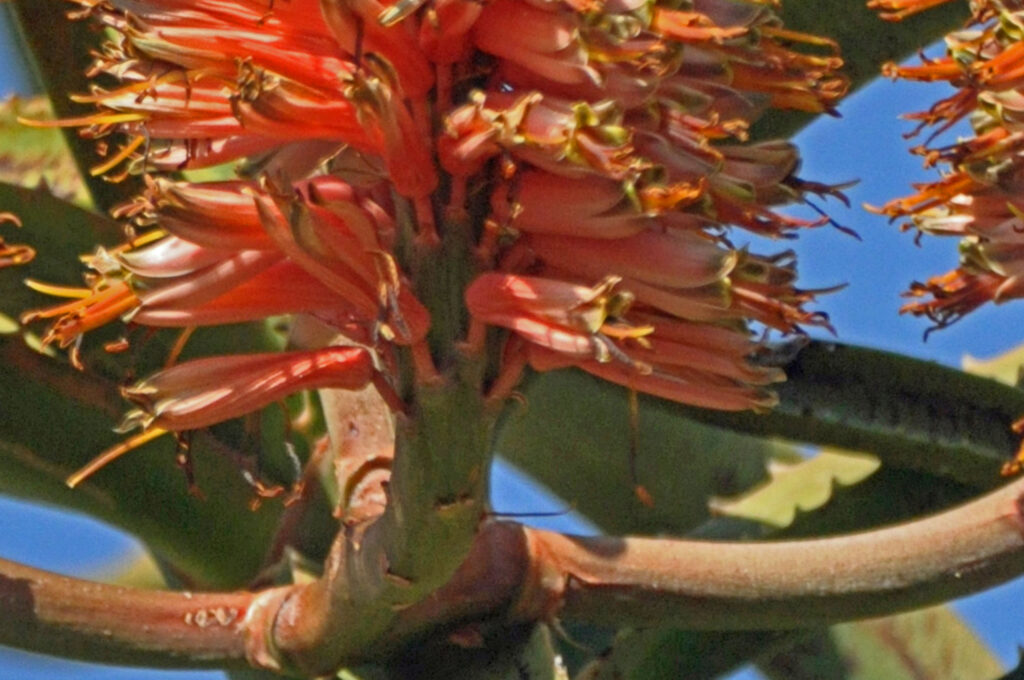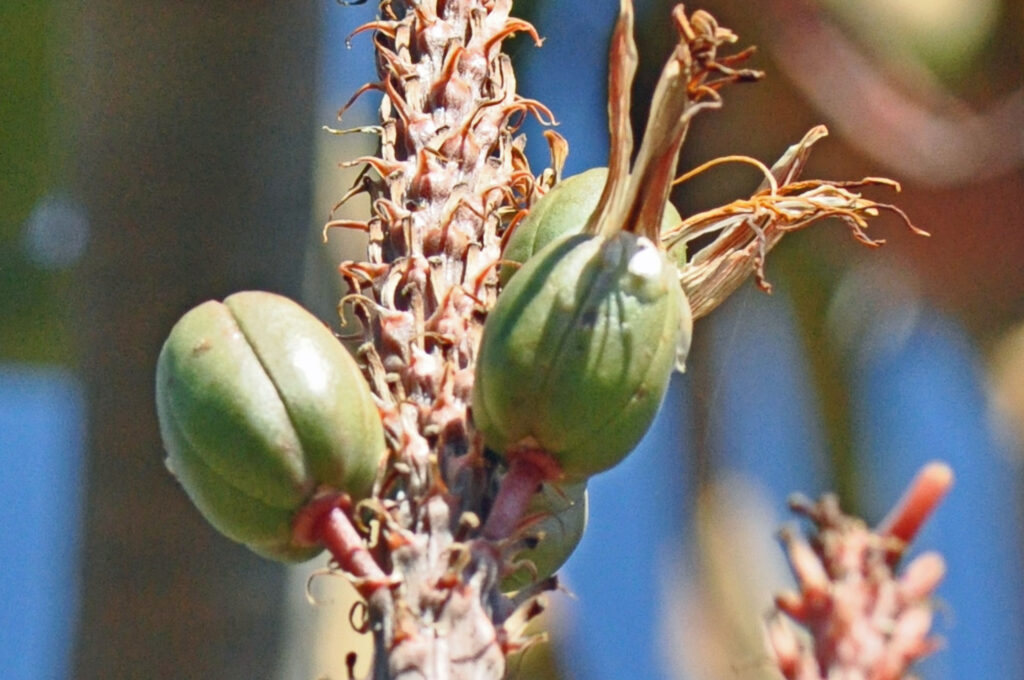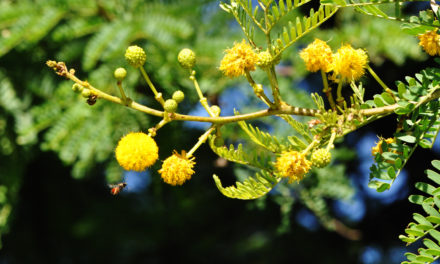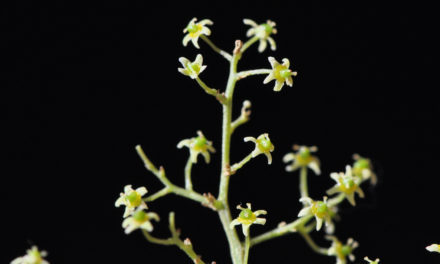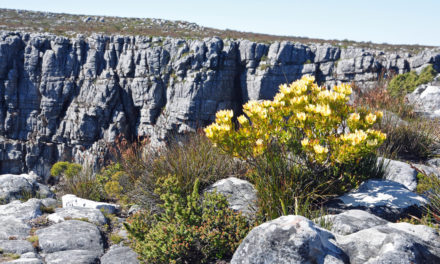Aloidendron barberae
General Info – summary
This, the tallest Tree of the genus, is up to 22m high with thin bark. Leaves do fall. They are recurved, amplexicaul, rosulate, and lack stipules. Only the margins are dentate. Reddish Flowers are in racemes. They are regular, 3-merous, bisexual, and produce nectar. Buds have green tips. Stamens 3+3. Both the superior ovary and the single style become exerted. Fruit is a capsule with irregularly angled seeds.
Description
Previous Names: Aloe bainesii var. barberae, Aloe barberae.
SA Tree No. 28.
Common names: (Afr) Boomaalwyn, Boom-aalwyn, Mik-aalwyn, Mikaalwyn, Oostelike Boomaalwyn. (Eng) Eastern Tree Aloe, Tree Aloe. (isiXhosa) Ikhala, Umgxwala, Uphondonde. (isiZulu) Impondondo, Indlabendlazi, Inkalane-enkulu, Inkalane Enkulu, Umgxwala, umhlabandliazi, Umhlabandlanzi, Umhlalampofu, Umpondonde. (siSwati) inhlaba.
Family Asphodelaceae (Aloe Family). Presumably derived from Asphodel Meadows, which is a section of the Ancient Greek underworld where indifferent and ordinary souls were sent to live after death. The family has about 40 genera and 900 species. There are 10 genera in South Africa. This is a small but wide-spread, mainly African family of perennial plants. All have Anthraquinones (an aromatic, organic compound, which are the main active constituents of herbs – often used to relieve constipation and may possess antifungal and antiviral activities. They are also widely used in dyes). When present, the Stems are fibrous and woody. The fleshy Leaves often have spines either on the margins or on the blades. The outer 2 flower whorls (the Perianth) lack the classic distinction between calyx and corolla and the lobes are called Tepals. These 2 whorls each have 3 tepals. Flowers are usually borne on a leafless stalk arising from the rosette of leaves. Individual flowers are regular. The 6 Stamens are inserted in 2 whorls of 3, below the superior 3 locular Ovary. Fruit is usually a dry Capsule. Genera with trees on this website include Aloe, Aloidendron and Kumara.
The name Aloidendron or ‘tree aloe’ dates to 2013 and is thanks to molecular studies that are rather shaking up phylogenies and thus classifications. About 20 of these are considered to be trees. The rambling aloes have also been put in their own genus: Aloiampelos.
Name derivation: Aloidendron – aloe (bitter sap) + dendron (tree-like). barberae after Mary Barber (1818-1899) who was a plant collector in the former Transkei. Her other interests were ornithology and entomology. She sent a specimen to KEW where it was named in 1874. Her contribution to science is worth reading about. Aloidendron barberae was first recorded in 1873 by the explorer and artist: Thomas Baines.
This scientific name has changed several times. The botanist that named it perpetrated that error. He named two specimens as one Aloe barberae and another Aloe bainesii then realised that they were the same species. The bainesii name stuck, but it was later realised that the barberae was published first and thus has precedence, so it is the valid name. The name Aloidendron or ‘tree aloe’ dates to 2013 and is thanks to molecular studies that are rather shaking up phylogenies and thus classifications. The rambling aloes have also been put in their own genus: Aloiampelos.
Conservation: National Status: L C. (Least Concern). Assessed 2018 (H. Mtshali and L. von Staden). This tree is now widely cultivated.
Tree
This succulent perennial is the Largest and Tallest Aloidendron species, as well as all the species in the genus Aloe. It may reach 22m high and the trunk usually has a diameter of up to at 1m – even wider in cultivation (photo 989). This photo shows the widest tree trunk that I have seen. The thickset trunk has expanding greyish almost smooth Bark (photo 839). The tree is often much Branched from about halfway up and re-branches occur more than once (photo 234). These branches collectively form a rounded crown (photos 390 & 234). Like Aloidendron dichotomum, branching often occurs by dividing into 2 parts (photo 234).
- 390M. 2015/05/19. Walter Sisulu NBG. Photo: David Becking.
- 234. 2011/03/12. Northcliff High. Photo: David Becking.
- 839. 2014/03/25. Walter Sisulu NBG. Photo: David Becking.
- 989. 2019/09/15. Kirstenbosch NMB. Photo: David Becking.
Leaves
The deeply channelled and recurved Leaves are situated at branch ends and form a rounded rosulate (forming a rosette) crown (photo 841). They are deeply grooved (photo 842), succulent, fairly thick, long, and narrow. Each leaf arches over and downwards (photo 841) and may reach 90 x 9cm. Leaves are a dull dark green and have parallel venation that is not that easy to see. The Margin is pale, may be pink (photo 842) and is dentate (with spreading, rather sharp Teeth that are usually perpendicular to the margin – photo 919). The smallish, whitish Teeth only appear on the margin (photo 919). Some teeth become brown tipped. The Base of the leaf is amplexicaul (a large leaf base that embraces a stem – photo 921). The Apex may end in a drip-tip (photo 841). Old leaves do not remain on the tree. They soon fall off the stem. Fallen leaves are initially still greenish and not very shrivelled. They leave a clear stem with small horizontal leaf scars (enlarged photo 841E).
- 841. 2014/03/25. Walter Sisulu NBG. Photo: David Becking.
- 921. 2014/03/25. Walter Sisulu NBG. Photo: David Becking.
- 919. 2015/03/25. Walter Sisulu NBG. Photo: David Becking.
- 842. 2015/08/11. Walter Sisulu NBG. Photo: David Becking.
- 841E 2014/03/25. Walter Sisulu NBG. Photo: David Becking.
Flowers
Each Inflorescence (a group or cluster of flowers arranged on a stem) branches dichotomously low down (photo 151S), and each branch contains a cylindrical upward pointing raceme (simple elongated inflorescence with stalked flowers that open in succession towards the apex – photo 151S). Each raceme may reach 50cm long. Pedicels (stalks of single flowers) – are visible in photo 150RR and 333M – under Fruit. In photo 1007, bracts (modified specialised leaf usually found with inflorescences and flowers) are clearly visible. Individual flowers are bisexual, cylindrical and actinomorphic (Regular, symmetrical. Flowers are vertically divisible into similar halves by more than 1 plane passing through the axis). Flowers are rose pink or orange, and each flower bud has a distinctive green tip (photo 151S). Individual flowers are up to 3,8cm long. Young flowers are initially erect but spread downwards or at least horizontally as they develop and open. This allows the insect pollinators to escape more easily. The Perianth (the 2 floral envelopes considered together, a collective term for the calyx and corolla) consists of 2 whorls of 3. All 6 are similar, resemble petals and are referred to as Tepals. The 6 exserted (sticking out, projecting beyond) Stamens (photo 150RR) are also in 2 whorls of 3. The superior Ovary is trilocular (3 compartments). The Stigma also protrudes from each open flower (photo 150RR). Flowers produce a great deal of nectar and collecting bees and sunbirds are at least partly responsible for pollination. (Apr-Jul).
- 1007. 2014/04/01. Walter Sisulu NBG. Photo: David Becking.
- 151S. 2016/05/31. Walter Sisulu NBG. Photo: David Becking.
- 150RR. 2016/05/31. Walter Sisulu NBG. Photo: David Becking.
Fruit
The Fruit is a trilocular Capsule (a dry fruit resulting from the maturing of a compound ovary with more than 1 carpel). In photo 333M, pedicels, capsules, old bracts and stamens (anthers and filaments) are still visible. The irregularly angled Seeds are wind dispersed.
- 333M. 2014/06/24. Walter Sisulu NBG. Photo: David Becking.
Distribution & Ecology
This not very common Tree is found in areas of heavy summer rainfall, little frost and in coastal areas in dense bush and forested kloofs (a narrow opening between hillsides or mountains that can be used for passage). It occurs naturally in the Eastern Cape (East facing slope e.g. East London) up through KwaZulu-Natal (East facing slope), and northwards into Eswatini (Swaziland), southern Mozambique, Mpumalanga and Malawi. This tree tends may be more common on east and south facing slopes.
Ethnobotany
This Tree grows rapidly (at least initially) from seeds and truncheons (stem cutting from a selected plant – used to produce genetically identically new plants) which should be left for a week after cutting and before planting, otherwise the ends tend to rot. Soil should be well drained e.g. on a slope. The plant has invasive Roots and should be planted away from buildings. Scale insect and aphid attack is controllable with an oil-based spray. The tree grows in almost any soil but is sensitive to heavy frost. It may be planted as a barrier around kraals.
References
Boon, R. 2010. Pooley’s Trees of eastern South Africa. Flora and Fauna Publications Trust, Durban.
Coates Palgrave, M. 2002. Keith Coates Palgrave Trees of Southern Africa, edn 3. Struik, Cape Town.
Lawrence, G. H. M, 1951. Taxonomy of Vascular Plants. The Macmillan Company, New York. Tenth Printing 1965.
Mtshali, H. & von Staden, L. 2018. Aloidendron barberae (Dyer) Klopper & Gideon.F.Sm. National Assessment: Red List of South African Plants version . Accessed on 2025/03/02.
Palmer, E. & Pitman, N. 1972. Trees of southern Africa. Balkema, Amsterdam, Cape Town.
Schmidt, S. Lotter, M. & McCleland, W. 2002. Trees and Shrubs of Mpumalanga and the Kruger National Park. Jacana, Johannesburg.
van Wyk, B. & van Wyk, P. 1997 Field guide to Trees of Southern Africa. Struik, Cape Town.
Alice Notten for explaining the name changes that have taken place.
2025 Merriam-Webster, Incorporated.
http://www.plantzafrica.com/plantab/aloebarber.htm
http://www.bioone.org/doi/abs/10.1600/036364414X678044?journalCode=sbot
http://veldfloraed.blogspot.co.za/search?q=Aloidendron+barberae+
http://succulent-plant.com/families/aloaceae.html
https://en.wikipedia.org/wiki/Mary_Elizabeth_Barber

